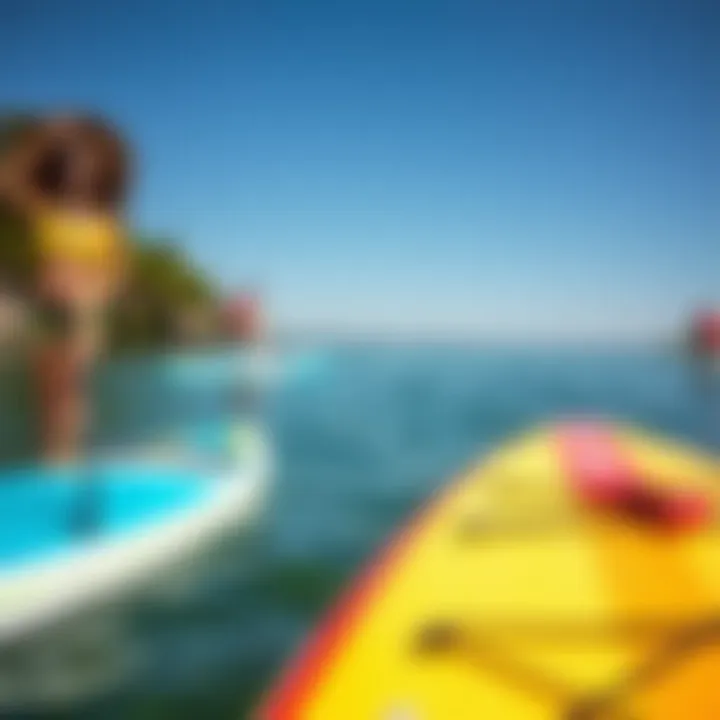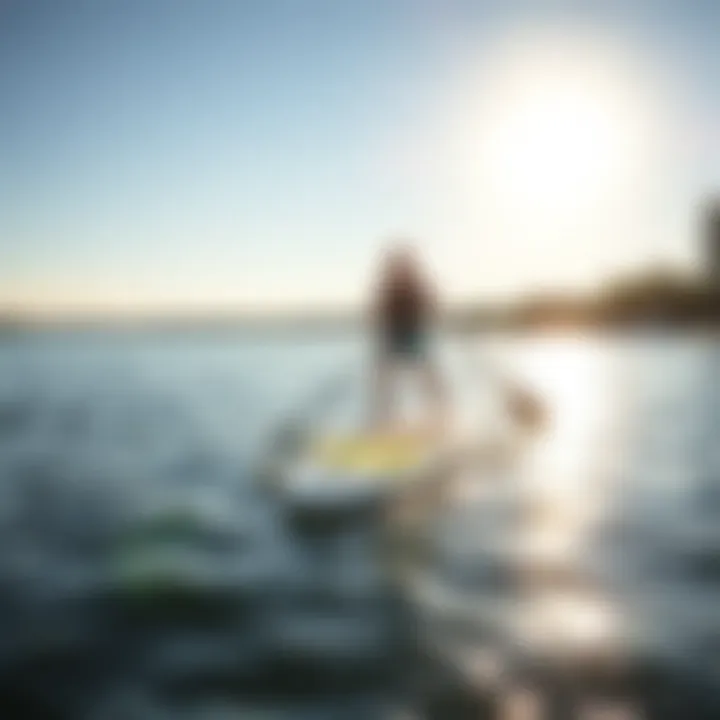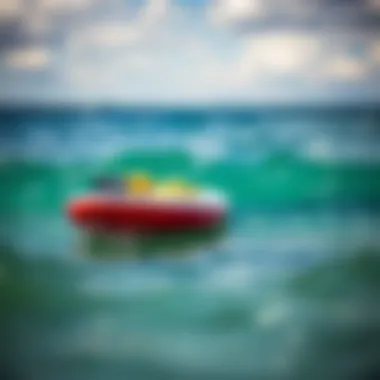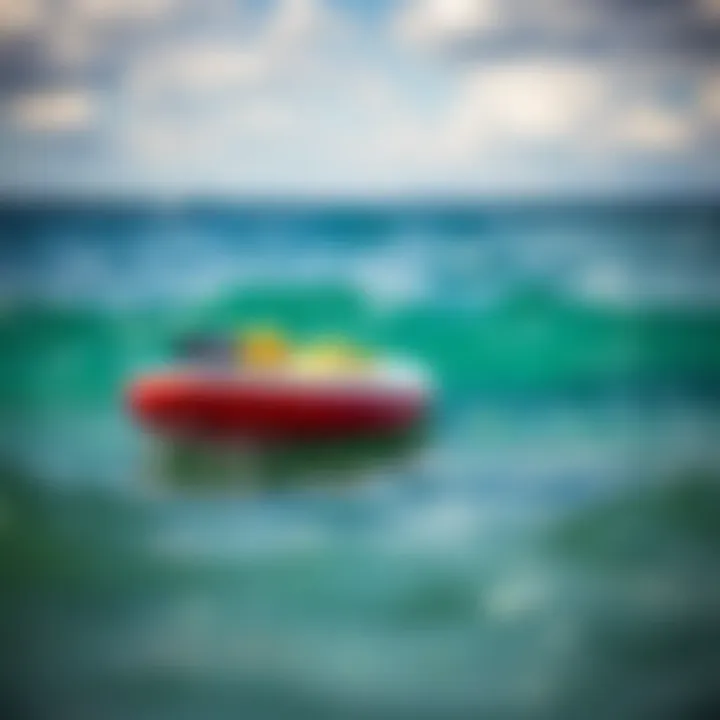A Detailed Guide to Inflatable Paddle Boards in Austin


Intro
Austin's vibrant waters mingle with an adventurous spirit. Paddle boarding has emerged as a favored pastime among locals and visitors alike, piquing interest in inflatable paddle boards. They're not only portable but also versatile, making them a top choice for exploring the variety of waterways in and around the city. As the sun glimmers off Lady Bird Lake, enthusiasts find themselves gliding smoothly across the water's surface.
Inflatable paddle boards have been making waves for their practicality. Unlike traditional boards, they can be deflated and rolled into a compact size, making transport and storage a breeze. This fundamental quality makes them especially appealing for those venturing to lakes, rivers, and even coastal shores. So, if you want to dip your toes into this dynamic hobby or hone your skills, you’re in the right place.
This guide unveils everything you need to know—from understanding the various types of boards available to identifying the best spots for paddle boarding in the Austin area. We’ll unravel local regulations to ensure compliance while you enjoy your time on the water. Additionally, we'll discuss maintenance tips that can help prolong the life of your inflatable board, ensuring countless adventures ahead. By the end, you’ll be empowered to navigate your paddle boarding journey with confidence and ease.
Prolusion to Inflatable Paddle Boards
Inflatable paddle boards have become a game-changer in the watersport arena, especially in vibrant locations like Austin, Texas. These boards not only cater to enthusiasts seeking leisure on the water, but they also offer a practical solution for those navigating limited storage spaces or who may not want to deal with the cumbersome nature of rigid boards. In this section, we will delve into the significance of inflatable paddle boards, emphasizing their various elements, advantages, and the considerations one should keep in mind before making a purchase.
One of the main draws of inflatable paddle boards lies in their portability. Users can easily roll them up and stash them in a vehicle’s trunk or a closet. This feature particularly appeals to those who like to hit the water on a whim, as they can simply pack their gear and head out without fuss. Furthermore, the expansion of recreational paddle boarding aligns seamlessly with busy lifestyles. After all, who wouldn’t trade a hefty board for something lightweight and storable?
Additionally, inflatable boards tend to be more forgiving upon hitting the waves. Their softer construction means that collisions or impacts are less jarring compared to their hard-shell counterparts. This characteristic is especially beneficial for beginners learning the ropes or for families looking to paddle with children. The cushioned surface translates into a comfier ride, granting paddlers an enjoyable experience on the water.
It’s also worth noting the array of designs and models available in today’s market. From all-around boards suitable for varied water conditions to specialized performance-oriented boards, there’s something for everyone. These options allow individuals to select a board that aligns with their skill level and intended use—whether for leisurely paddling, yoga, or racing.
However, with variety comes choice overload. When considering a purchase, individuals must keep in mind factors such as volume, weight capacity, and even the intended water environments where they will paddle. The right balance among these elements can enhance performance and overall enjoyment. If not thought out closely, buying a board that does not fit one's specific needs can lead to disappointment.
"Choosing the right inflatable paddle board requires careful thought; what works well for one person may not be ideal for another."
In summary, inflatable paddle boards represent a remarkable evolution in the paddle boarding community, blending convenience and versatility with user-friendliness. They hold tremendous potential for both novices and seasoned paddlers alike. As we continue to explore the specifics of inflatable paddle boards throughout this guide, we will uncover the deeper insights that enhance the paddling experience, ensuring enthusiasts in Austin can make informed decisions for their water adventures.
The Rise in Popularity of Paddle Boarding
Paddle boarding is making quite a splash, especially in vibrant locales like Austin. As the sport has gained traction, understanding why it's becoming a favorite can offer insights into its benefits and applicability for different people. Beyond mere fun, paddle boarding is an engaging way to explore nature while slipping in a great workout. It's evident that the rise in popularity isn't just a whim; there's substance behind it.
Historical Context
The roots of paddle boarding can be traced back to ancient Polynesian cultures, where it was commonly used for fishing and transportation across islands. However, it wasn’t until the last couple of decades that this age-old discipline transformed into the popular aquatic pastime we recognize today. Starting in the Hawaiian surf scene, where surfers began to stand on longboards to gain a better view of the waves and to take photos, it morphed into a full-fledged activity.
Today, its evolution is tied closely to the growing interest in outdoor activities. As more people seek to disconnect from daily routines and experience nature firsthand, paddle boarding offers an accessible way to engage in physical activity while enjoying the tranquility of water, making it an appealing choice for diverse audiences.
Current Trends
In recent years, paddle boarding has captured the imagination of the masses. A glance around any lake or riverside in Austin reveals the colorful array of inflatable boards dotting the water. This trend reflects a few significant factors:
- Accessibility: With inflatable boards hitting the market in various shapes and sizes, they're easier to transport and store compared to rigid boards.
- Social Media Influence: Platforms like Instagram and TikTok have fueled interest, with countless influencers sharing their experiences, captivating new audiences.
- Wellness Focus: The contemporary population leans toward fitness routines that combine enjoyment with health benefits. Paddle boarding fits the bill by mixing aerobic exercise with serenity, attracting fitness enthusiasts and those seeking relaxation alike.
Moreover, events and gatherings are popping up all over, from paddle board races to yoga classes held on boards. The community aspect is blossoming, with clubs forming to engage both novices and seasoned paddlers.
The combination of a thriving community and a diverse user base creates continuous interest in paddle boarding, shaping it as a lasting trend rather than a fleeting phase.
Inflatable vs. Rigid Paddle Boards
When it comes to paddle boarding, a recurring question surfaces: should you go for an inflatable board or a rigid one? This inquiry is more than just preference; it delves into the distinct functionalities, advantages, and disadvantages each type offers. Understanding these differences can significantly influence your paddle boarding experience, especially in a vibrant location like Austin.
Advantages of Inflatable Boards
Inflatable paddle boards are winning hearts (and waves) for numerous reasons:
- Portability: Possibly the most obvious perk is their ability to deflate and roll up into a manageable size. You can easily toss it in your trunk or carry it on your back. Forget the days of wrestling a bulky board onto your roof rack.
- Lightweight: Inflatable boards are generally lighter than their rigid counterparts. This makes them an ideal choice for those who may not have the physical strength for heavy lifting or for travelers wanting convenience during outings.
- Durability: Contrary to popular belief, inflatable boards are built tough. They often feature reinforced seams and materials designed to withstand scrapes and impacts that might leave a rigid board worse for wear. Hit a rock? No problem; an inflatable can bounce right back!
- Stability: Most inflatable boards offer a wider design, which adds to overall stability. This makes them particularly inviting for beginners or those paddling in choppy waters. The extra surface area allows riders to feel safe and secure, even in less-than-ideal conditions.
- Affordability: While prices vary, many inflatable options tend to be more budget-friendly compared to premium rigid boards. This makes them an attractive choice for first-time buyers curious to wade into the sport without breaking the bank.
Disadvantages to Consider
That said, inflatable boards are not without their caveats:
- Inflation Time: To be fair, they require some setup time, because you must inflate them before hitting the water. Depending on the pump you use, this can take from a few minutes to quite a bit longer.
- Performance: Some experienced paddlers may argue that rigid boards provide better speed and efficiency. If you’re looking for high-performance paddling, especially for racing or long-distance trips, the rigidity might offer a significant edge.
- Surface Feel: Many paddlers feel that traditional boards offer a more direct connection with the water. The stiffness of rigid boards can provide a feel that enthusiasts often prefer for nuanced maneuvers and tricks.
- Storage Concerns: While inflatable boards are hailed for their portability, they do need the right conditions for storage. Being exposed to extreme temperatures (either hot or cold) could affect their longevity, making proper storage a necessity.
- Leak Risks: Though built tough, inflatable boards can face punctures or leaks. Over time and with regular use, small holes may develop. It’s essential to keep an eye on their condition.
In summary, the choice between inflatable and rigid paddle boards ultimately depends on personal preferences and intended use. For those prioritizing convenience and stability, an inflatable board is hard to beat. However, serious racers and those who paddle with specific performance goals in mind might lean toward rigid options. Think about your paddling style and where you plan to head out on the water before making the plunge.
Selecting the Right Inflatable Paddle Board
When it comes to inflatable paddle boards, not all are created equal. Choosing the right one is vital to enjoying the serene waves, rivers, and lakes around Austin. The wrong board can lead to discomfort, instability, and ultimately, a lackluster experience on the water. Therefore, knowing what to look for can make all the difference.
Understanding Dimensions
Dimensions play a significant role in how well a paddle board performs. When we talk about dimensions, we're essentially referring to length, width, and thickness. Each of these factors influences speed, stability, and maneuverability.
- Length: Longer boards generally track straighter and glide better through the water. If you're planning to paddle long distances, something around 10 to 12 feet may suit you best. However, shorter boards are more maneuverable, making them an excellent choice for navigating tight spots like the nooks along Lady Bird Lake.
- Width: This affects stability. Wider boards are more stable, perfect for beginners or those looking to do yoga on their boards. A board around 30 inches wide tends to provide enough balance without compromising speed too much.
- Thickness: Thicker boards tend to have more buoyancy, which is great for paddlers on the heavier side. Additionally, a thicker board can often handle choppier waters better than a thinner option.
Understanding these dimensions is crucial for tailoring your paddle boarding experience to your needs.
Weight Capacity and Stability


Another critical element in selecting the right inflatable paddle board is weight capacity. Each board comes with a specified limit, which is not just about the weight of the paddler but includes any gear you might take along. It's important to account for your own weight and any extra cargo.
- Stability: A board that’s rated for your weight provides a solid platform. If you exceed the board's capacity, it can become unstable and hard to control.
- Settling Under Load: A paddle board's performance can change under load. A well-matched weight capacity helps maintain its shape and buoyancy, ensuring that you won’t tip over at the slightest wake.
- Varied Activities: If you plan to carry a child or pet while paddling, choosing a board with a higher weight capacity is a wise move. It ensures enough stability for both your adventure and enhances the fun for everyone involved.
Material Considerations
The materials used in inflatable paddle boards affect not just durability but also performance. Most inflatable paddle boards are crafted from either PVC or drop-stitch technology, but there are nuances worth noting.
- PVC: Boards made from PVC are often less expensive and are good for recreational use. They can withstand impact reasonably well, making them a good choice for occasional users.
- Drop-Stitch: This technology involves thousands of polyester threads connecting the top and bottom layers of the board. This greatly increases rigidity, allowing the board to handle larger waves and more intense paddling activities. It’s particularly well-suited for those who plan on extensive trips or challenging conditions.
- Fin Types: The fins also come in different materials—plastic, fiberglass, or a combination. A permanent fin tends to be more durable, while removable fins can allow for custom configurations depending on your paddling preferences.
Choosing wisely among these materials affects the lifespan and performance of your inflatable paddle board. It's all about striking a balance between durability and the type of activities you plan to engage in.
By considering dimensions, weight capacity, and the materials, you’ll be well on your way to selecting an inflatable paddle board that suits your needs while enjoying the bountiful waterways of Austin.
Key Brands and Models Available in Austin
When exploring inflatable paddle boards in Austin, knowing the key brands and models available in the market is crucial. Quality matters here; the right selection can make or break your paddle boarding experience, affecting everything from stability to portability. This section sheds light on the popular brands that dominate the market and provides insights into various models to help you make an informed choice.
Popular Brands
Brand A
Brand A stands out for its commitment to quality and performance. Known for their durable materials and innovative designs, they produce boards that cater to both beginners and seasoned paddlers. One significant characteristic of Brand A is the incorporation of lightweight yet robust construction, which allows easy handling and transportation. This is especially beneficial for those who may want to hike to a paddleboarding spot, as the lightweight design makes it less of a burden.
Their most noteworthy feature is the integrated storage options, allowing paddlers to stow away essentials neatly. However, some users have noted that the fin setup can be a tad finicky, requiring a bit of patience initially. Overall, Brand A remains a strong contender for anyone looking to invest in a reliable paddle board.
Brand B
Moving on, Brand B has gained popularity for its fantastic balance between affordability and quality. Most notable is their unique manufacturing process which focuses on environmental sustainability without compromising on performance. This eco-friendly approach is something many Austin paddlers appreciate, given the city's emphasis on conservation.
One key selling point of Brand B is its boards' adaptability; whether you are interested in leisure paddling or more adventurous outings, they've got something that fits the bill. The downside? Their boards can sometimes lack the speed that more competitive designs offer. Still, for those seeking a versatile option without breaking the bank, Brand B is a solid choice.
Brand
Brand C caters to the high-performance segment of the paddle boarding community. These boards are crafted for more rugged use and are built to withstand tougher conditions. One key characteristic of Brand C is their superior stability and tracking, making them ideal for those long excursions on Lake Austin or even adventurous trips down the rivers.
What sets Brand C apart is their patented design technology, which enhances buoyancy and allows for a smooth ride. The disadvantage, however, can be their price point, which might not appeal to the casual paddler. Still, if you’re looking for an upgrade and serious performance, Brand C is definitely worth considering.
Model Comparisons
When it comes to selecting a model, a side-by-side comparison can be very revealing. Each brand has its range of models, each suited for different paddling styles. Here are some points to compare:
- Stability and Tracking: Assess the design and fins offered, especially if you plan on paddling in choppy waters.
- Portability: Look at the weight and packing size, particularly if you plan on hiking to locations.
- Price Range: Determine what features are worth the price; some models may have premium prices without significant performance benefits.
- User Feedback: Reviews can be invaluable in gauging how these boards perform in real-world scenarios.
Where to Paddle Board in Austin
Paddle boarding has become a beloved pastime in Austin, and understanding where to paddle board is key to making the most of this aquatic experience. The city boasts a variety of stunning locations that cater to both novices and experienced paddlers. From sprawling lakes to serene coves, knowing the right spots will not only enhance your skills but also your enjoyment of the beautiful Texas landscape. Before diving into the specifics, it’s important to consider factors such as crowd levels, water conditions, accessibility, and the type of experience you're seeking.
Lady Bird Lake
Lady Bird Lake is arguably the crown jewel for paddle boarding in Austin. Nestled in the heart of the city, it offers a scenic backdrop of downtown skyscrapers mixed with rugged nature. The calm waters are perfect for newcomers who may feel a bit wobbly at first.
- Access Points: There are multiple access points such as the Lamar Beach or Zilker Park, making it easy to hop in and out.
- Amenities: The lakeside parks typically have facilities like restrooms and picnic areas, perfect for families looking to enjoy a full day outdoors.
- Scenic Views: Paddle along the water to enjoy views of the iconic Austin skyline, especially stunning during sunset.
- Wildlife: Keep an eye out for various bird species and the occasional turtle alongside the shoreline.
In Lady Bird Lake, there is always something happening—be it an impromptu gathering or some local event. The vibrant community can make your paddle boarding experience feel even more lively.
Lake Austin
Just a short drive from downtown, Lake Austin provides a different atmosphere altogether. It's more expansive and has variability in its water conditions, appealing to both leisure paddlers and thrill-seekers alike.
- Wider Waters: Lake Austin retains a more boating-oriented crowd, so expect to share the waters with motorized vessels.
- Inlets and Estuaries: You can explore quieter areas by paddling into its many inlets and estuaries—these hideaways can be quite peaceful and less trafficked.
- Fishing Opportunities: For those inclined, this lake is a good spot for fishing; you might even want to cast a line after you're finished paddling!
- Local Cafes: Many boat docks and eateries dot the shoreline, so a paddle board outing here can easily transition into a leisurely lunch at a lakeside café.
Safety Note: With motorboats zooming by, being aware of your surroundings and practicing extra caution is a must at Lake Austin.
Commonly Overlooked Spots
While Lady Bird Lake and Lake Austin are popular hotspots, a treasure trove of lesser-known locations exist that offer the same charm with fewer crowds.
- Bull Creek: Tucked away in its tranquil setting, Bull Creek is perfect for those seeking peace. The natural rock formations and lush scenery create an idyllic backdrop.
- Lake Travis: This is a bit of a trek but offers a vast expanse of water. Ideal for full days of exploration, Lake Travis has numerous islands and secluded beaches waiting to be discovered.
- Cedar Park’s Brushy Creek: If you’re looking for something different, this creek boasts quiet waters surrounded by nature. Ideal for a more beginner-friendly session or a calm day paddling with kids.
"It’s not all about the popular spots; sometimes the most memorable paddling experiences can be found off the beaten path."
Local Regulations and Safety Considerations
When venturing out onto the water in Austin with inflatable paddle boards, understanding local regulations and safety considerations is paramount. These guidelines not only ensure a seamless outing but also play a critical role in maintaining the tranquility and safety of these beautiful waterways. Paddle boarding is a beloved activity, but it comes with its own set of responsibilities that enthusiasts should not overlook.


Permits and Fees
Navigating the rules of the water can be complex. Each body of water may have specific requirements regarding permits and fees. For instance, using Lady Bird Lake might necessitate a permit, while other areas like Lake Austin may have fewer restrictions. Here are some points to keep in mind:
- Check Local Guidelines: Always verify Austin’s Parks and Recreation Department’s website, as local laws can change.
- Costs Vary: Permits usually have a fee, which may range from a few dollars to about twenty dollars depending on the lake and the duration of your stay.
- Group Registrations: If you're with a club, you might qualify for group permits, which could reduce individual costs.
"Knowing the regulations keeps our lakes clean and enjoyable for everyone. Don't be a stranger to the laws that keep our water pristine!"
Following regulations allows all paddle boarders to enjoy the sport without unwanted disruptions. Often, you can opt for annual passes if you paddle frequently, saving yourself some cash in the long run. But remember, failing to obtain a permit can lead to hefty fines, which is something nobody wants to deal with.
Safety Gear Recommendations
Safety should never take a back seat while paddle boarding. As you glide on Austin's waters, having the right safety gear can mean the difference between a fantastic day out and an unexpected mishap. Here are essential items to consider:
- Personal Flotation Device (PFD): It’s wise, if not mandatory, to wear a life jacket, especially in busy areas. Some lakes may even require all participants to have a life jacket on hand.
- Leash: A leash will keep your board close, preventing it from drifting away and ensuring you can quickly regain your balance if you take a tumble.
- Sun Protection: Sunscreen, sunglasses with UV protection, and hats protect against the strong Texas sun.
- Whistle: This might seem trivial, but having a whistle can be a lifesaver when in distress.
Packing these essentials will not only keep you safe but can also enhance your experience on the water. The cares of everyday life can melt away when you're prepared, allowing you to fully enjoy the sights and sounds of nature. Safety practices should be second nature; when you're equipped correctly, you're free to paddle with peace of mind.
Inflatable Paddle Board Maintenance
Taking care of your inflatable paddle board is crucial for ensuring its longevity and performance. These boards can be a bit of an investment, and proper maintenance can make all the difference in extending their usable life and keeping them in top condition. Whether you paddle along the serene waters of Lady Bird Lake or challenge the currents of Lake Austin, a well-maintained board enhances your experience significantly. In this section, we delve into the essentials: cleaning techniques, storage best practices, and other considerations to keep your inflatable companion in prime shape.
Cleaning Techniques
Cleaning your inflatable paddle board can feel like a chore, but really, it's a small step that reaps big rewards. For most boards, a gentle rinse with fresh water after each use is a wise practice. Here’s how you can do it effectively:
- Rinse Thoroughly: Saltwater or muddy water can degrade the material if not rinsed off. After every outing, just give your board a solid rinse to wash away any grime.
- Mild Detergent: If your board has a stubborn stain or dirt that won't budge, mix a mild detergent with water. Use a soft sponge and scrub gently to avoid damaging the surface. No need for heavy-duty cleaners, which can be harmful.
- Drying: After washing, allow your board to dry fully. Place it in the shade to prevent sun-related damage. Hanging it upright works best for airflow.
"Regular cleaning of your board isn’t just about aesthetics; it helps to prolong the material’s life and maintain its buoyancy."
Storage Best Practices
Where and how you store your inflatable paddle board can significantly affect its condition. Here are some tips to store it properly:
- Deflate When Not in Use: While it might seem convenient to keep it inflated, deflating your board for storage is a better option. This reduces the chances of damage from pressure buildup.
- Choose the Right Place: Store your board in a dry, cool space away from direct sunlight. Excess heat can warp the material, while intense UV exposure can break down the fabric over time.
- Use a Board Bag: Investing in a quality storage bag can protect your board from dust and accidental bumps. Choose a bag that has some padding to keep it safe.
- Keep it Elevated: If you're storing it long-term, keep it off the ground. A shelf or a dedicated rack minimizes the risk of mildew and pest interaction.
Maintaining your inflatable paddle board through careful cleaning and proper storage not only safeguards your investment but enhances your overall experience in the water. A well-maintained board will glide more smoothly over the waters of Austin, allowing you to enjoy every moment spent on the waves.
Accessories for Enhancing Your Experience
Engaging in paddle boarding isn’t just about the board itself; it is also about the gear and accessories that come along with it. Having the right accessories can significantly elevate your experience on the water. Not only do they enhance safety, but they also improve convenience and performance. When thinking about your paddle boarding experience in Austin, considering what you bring along can make all the difference. Here’s a closer look at two crucial elements: paddles and life jackets, as well as hydration and storage solutions.
Paddles and Life Jackets
When it comes to paddle boarding, your paddle can be the difference between smooth sailing and a workout you might regret. A good paddle should be lightweight, adjustable, and suited to your paddling style. Typically, you’ll find paddles made from materials like aluminum, fiberglass, or carbon fiber. Aluminum is sturdy but heavier, while carbon fiber is light and a bit pricier. Make sure to test different paddles before committing—sometimes it’s best to get a feel for it yourself.
As for life jackets, here in Texas, they are not just a good idea; they’re a legal requirement for anyone under the age of 13. Choosing the right life jacket is paramount. Look for one that is buoyant and fits comfortably without being restrictive. There are various styles, including vests and inflatables, with vests offering more buoyancy for beginners. For an enhanced experience, consider getting a life jacket designed for paddle boarding. Many of them feature pockets for gear, which keeps your essentials at hand.
"Safety first should be your mantra when hitting the water—better safe than soggy."
Hydration and Storage Solutions
Staying hydrated while paddling is important, especially in the Texas heat. Dehydration can sneak up on you, so bringing water is essential. Look for hydration packs or water bottles designed for water sports. Some packs have a straw for easy sipping without needing to pause your paddling, which is a must if you want to keep your groove on the water.
Besides hydration, having a reliable way to store your items is key. Many inflatable paddle boards come with bungee storage areas, but for extra security, consider a waterproof dry bag. These bags can protect your belongings from splashes or accidental dunking. It’s a smart way to carry your phone, wallet, or any gear you might want while paddling. Look for dry bags that are lightweight and have an easy-to-carry shoulder strap, making it easier to transport from your vehicle to the water.
Choosing the right accessories is like packing your toolbox before starting any project. The right equipment not only addresses safety but also fortifies your overall paddle boarding experience. Don’t skimp on these essentials if you’re looking to enjoy Austin's stunning waters more fully.
Packing and Transporting Your Inflatable Board
When venturing out to paddle in the beautiful waters of Austin, knowing how to pack and transport your inflatable paddle board is essential. Proper packing ensures that your board remains in great condition, while effective transportation methods help make your trips hassle-free. Let’s dive into some of the specifics that can greatly enhance your overall experience.
Best Practices for Inflation
Inflating your paddle board may seem straightforward, but there are a few best practices you should stick to, ensuring your board maintains its integrity and performance. First off, always use a reliable pump designed specifically for inflatable paddle boards. A manual pump can work, but an electric pump will save you time and energy, making the process much smoother.
- Check the Pressure: Before starting your paddle adventure, it's vital to check the desired pressure level recommended by the manufacturer, typically between 12 to 15 PSI. This pressure ensures a balance between stiffness and stability.
- Inflate in a Controlled Environment: Try to inflate your board in a shaded area. Heat can cause pressure to rise unexpectedly as the day warms up.
- Don't Overinflate: While it's tempting to pump as much air as possible for rigidity, be cautious. Overinflation can lead to fails or damage during use, particularly under differing temperature conditions.
- Secure the Valve: Always make sure the valve is securely closed after inflation. A failing valve can lead to unwanted air leakage, ruining your day out on the water.
Transport Tips for Vehicles
Transporting your inflatable paddle board requires some thoughtfulness to prevent damage and ensure easy access. Whether you're driving a hatchback or a larger vehicle, these tips can simplify the process:
- Use a Board Bag: Invest in a good quality board bag for extra protection. It keeps your board safe from scratches and dings while also making it easier to carry.
- Lay It Flat: Whenever possible, lay the board flat in your vehicle. Secure it with straps or tie-downs if needed. This approach reduces the risk of bending and maintains the board's structure.
- Avoid Sharp Objects: Ensure there are no sharp objects around your board. They can easily puncture your board, ruining your day.
- Secure it Properly: Use straps or bungee cords to secure the board within your vehicle. This prevents it from moving around during transit. If you’re using a roof rack, ensure the board is tightly secured to avoid any mishaps on the road.


"Your inflatable paddle board is an investment. Treat it with care during transport and inflation to ensure it lasts for many adventures."
By adhering to these packing and transport tips, you can enjoy your paddle boarding experience in Austin with less worry and more excitement. Remember, a little caution goes a long way in preserving your paddle board for the long haul.
With the right approach, you can maximize your enjoyment out on the water and keep your paddle board in top shape for every outing.
Community and Events in Austin
Austin's paddle boarding scene extends beyond the simple thrill of gliding across its beautiful lakes. The community of paddle board enthusiasts here fosters a vibrant culture filled with activities and camaraderie. From casual meet-ups to organized events, being part of this community offers a unique way to connect with others who share a similar passion for water sports.
Locally, paddle boarding clubs and events serve multiple purposes. They provide valuable networking opportunities, support sustainable practices, and promote physical fitness. Participating in group activities can amplify the enjoyment level; you can discover different techniques, take part in guided tours, or simply share stories of your adventures on the water.
The sense of belonging to a community is irreplaceable, often leading to lasting friendships and unforgettable experiences.
Additionally, these gatherings can help beginners find their footing. Seasoned paddlers often lend a hand, sharing tips on board handling, balance, and water safety. Learning from others can save time and enhance skills, making the learning curve less daunting. Here’s how you might get the most out of local events:
- Networking: Meeting fellow paddle boarders can open doors to discussions about new gear, local conditions, and potential buddies for future paddling sessions.
- Fitness Insights: Join exercise-focused paddle boarding sessions to improve your strength and endurance, benefiting body and mind.
- Environmental Awareness: Many groups emphasize conservation, organizing clean-up efforts along Lake Austin or Lady Bird Lake that make a positive impact on the environment.
Indulging in the community spirit of Austin's paddle boards isn't just about the sport; it's a pathway to a holistic experience involving nature, personal growth, and enjoyment. Adjoining this pursuit with local events only enriches the experience.
Local Paddle Board Clubs
Dallas has various paddle board clubs that not only cater to enthusiasts but also help newcomers ease into the sport. Clubs such as Austin Paddle Sports and Texas Paddle Board Club bring together individuals of all skill levels. They often organize weekend paddling sessions where members can explore different water bodies, ranging from serene lakes to challenging rivers.
Membership might also grant access to a library of resources, including training sessions, rental deals, and special events. Moreover, being part of a club often enhances safety. Paddling with a group can help ensure that you have assistance in case of an emergency. Many clubs encourage novice paddlers to join their gatherings, promoting an inclusive atmosphere that values learning and friendship over competition.
Upcoming Competitions and Gatherings
The paddle board calendar in Austin is lined with exciting events ranging from friendly races to community engagement initiatives. Events such as The Texas Paddleboard Race Series bring out paddlers from across the region, allowing them to showcase their skills while experiencing the thrill of competition. Such events often come with categories tailored to various skill levels, ensuring everyone can participate and enjoy the day.
Moreover, some gatherings focus on specialized activities such as yoga on paddle boards, which is a perfect mix of physical and mental exercise. Participate in these unique experiences to gain a fresh perspective on the sport while also deepening your connection with fellow paddlers.
In listing to mark your calendars, take note:
- Races are often held seasonally, providing a dynamic platform for users at every level.
- Fitness Events may include guided workouts or yoga sessions on the water.
- Social Gatherings often feature food trucks, live music, and other festivities that celebrate the local culture.
In summary, engaging with the paddle boarding community in Austin is not merely a recreational activity; it is an enriching lifestyle choice that promotes health, sustainability, and meaningful connections. Whether participating in organized events or joining local clubs, there are countless ways for paddle boarding enthusiasts to dive into a fulfilling experience.
Environment and Conservation Efforts
When discussing inflatable paddle boards, it's easy to get caught up in the thrill of cruising along Austin's beautiful waterways. However, it's also crucial to recognize the impact our activities can have on the environment. This section sheds light on the intersection of paddle boarding and conservation, highlighting why protecting our aquatic ecosystems matters not just to local wildlife, but also to paddlers themselves. The health of bodies of water affects everything from water quality to the availability of recreational activities.
Paddle boarding provides a unique vantage point for observing local ecosystems. Whether it's spotting turtles basking in the sun or witnessing the intricate dance of fish beneath the surface, the experience can deepen one's appreciation for nature. With great enjoyment comes responsibility. Maintaining the integrity of these ecosystems should be a priority for every outdoor enthusiast. The following subsections delve into the environmental implications of paddle boarding and highlight ways to contribute positively to our surroundings.
Impact of Paddle Boarding on Local Ecosystems
Paddle boarding, while a generally low-impact activity, still has potential repercussions on local ecosystems. When paddlers venture out onto lakes or rivers, they can inadvertently disturb habitats crucial for various aquatic species. For instance, several fish spawn in shallow areas, which are commonly accessed by paddle boards. If these zones are consistently disrupted, it could lead to issues with fish populations over time.
Moreover, paddle boards can introduce contaminants through paddlers' gear or by litter that might wash off during trips. The very act of paddling can stir up sediments that may contain pollutants, affecting water quality further downstream.
"Every paddle out is a chance to foster connection, not just with the water, but the life that thrives in it."
Nevertheless, the overall footprint of paddle boarding is lighter compared to motorized boating. Therefore, through conscious practices, paddlers can mitigate their impact. Choosing paths that avoid sensitive habitats and keeping a safe distance from wildlife can go a long way in preserving ecosystem vitality.
Participating in Cleanup Initiatives
One of the best ways to give back to the environment while engaging with paddle boarding is to join local cleanup initiatives. Many communities in Austin organize events aimed at keeping their waterways clear from debris. As enthusiasts head out on their boards, they often bring along trash bags, turning their adventure into a chance to contribute positively to the landscape.
Participating in these cleanups not only enhances the beauty of the waterways but also fosters a sense of community among paddlers. It's an opportunity to meet like-minded individuals who share a passion for both paddle boarding and environmental stewardship. Engaging with local conservation groups can provide further insight into other conservation efforts such as habitat restoration or advocacy for cleaner water legislation.
Some popular organizations in Austin that focus on environmental cleanup and awareness include:
- Keep Austin Beautiful: A well-known nonprofit aimed at enhancing the city's natural beauty.
- Austin Water: They regularly organize events to keep local waterways safe and clean.
- The Texas Park and Wildlife Department: They often provide resources and support for conservation programs.
Involvement in such initiatives makes you not just a visitor but a steward of the environment. Transforming a paddleboarding session into a cleanup can not only lead to a more enjoyable experience on the water but also ensures that the beauty of our natural resources is preserved for future generations.
Ending: The Future of Paddle Boarding in Austin
As we peer into the future of paddle boarding in Austin, it’s clear that this aquatic activity is more than just a passing trend. The evolution of inflatable paddle boards heralds a new chapter for enthusiasts across the city. Factors such as ease of transport, affordability, and versatility have already drawn more explorers to the water, and this keeps the momentum rolling.
The growing interest in paddle boarding is tied closely to Austin’s outdoor culture. This city, often buzzing with live music and food festivals, is nestled within stunning natural landscapes that invite adventure. The lakes and rivers not only provide the ideal backdrop but are also crucial for recreational activities that promote community interaction and well-being.
Our connection to nature plays a significant role in shaping the future of paddle boarding. A recent rise in eco-consciousness has led many local paddle boarders to engage in conservation efforts. Many are now participating in cleanup initiatives that safeguard the very ecosystems they enjoy. This not only enhances the quality of local waterways but fosters a sense of responsibility within the paddling community.
In terms of innovation, manufacturers are continuously refining designs to make inflatable boards even more user-friendly and robust. Features like additional compartments for gear, improved valve systems for easier inflation, and eco-friendly materials indicate that the industry is evolving to meet both user preferences and environmental needs. Moreover, wave-riding technology is advancing, making inflatable boards suitable for a wider range of water conditions.
Austin is also a melting pot for paddle board events. Upcoming competitions and gatherings facilitate community building and foster camaraderie among both seasoned paddlers and newcomers eager to learn. This thriving social scene contributes to the sport's ongoing popularity, as new participants are encouraged to dive in, quite literally.
The fusion of these elements makes the future of paddle boarding in Austin not just bright, but dynamic. As people continue to embrace outdoor activities for recreation and fitness, paddle boarding stands as a formidable option — appealing to surfers, travelers, and fitness enthusiasts alike. With picturesque venues like Lady Bird Lake and Lake Austin becoming integral to the experience, it remains to be seen just how far this sport will evolve.
"The future of paddle boarding isn't just about the sport itself but the culture it cultivates and the community it fosters."



